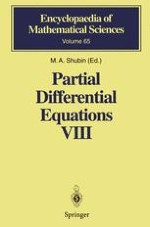1996 | Buch
Partial Differential Equations VIII
Overdetermined Systems Dissipative Singular Schrödinger Operator Index Theory
herausgegeben von: M. A. Shubin
Verlag: Springer Berlin Heidelberg
Buchreihe : Encyclopaedia of Mathematical Sciences
Enthalten in: Professional Book Archive
